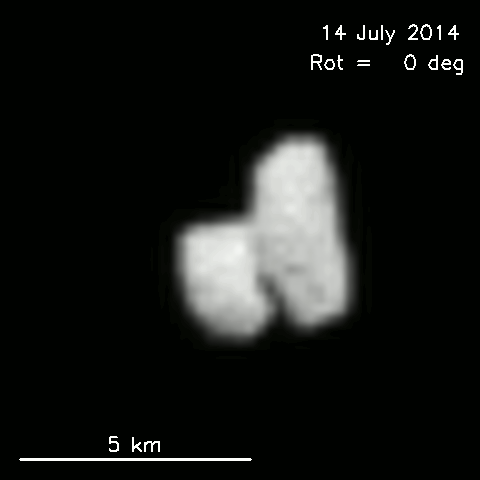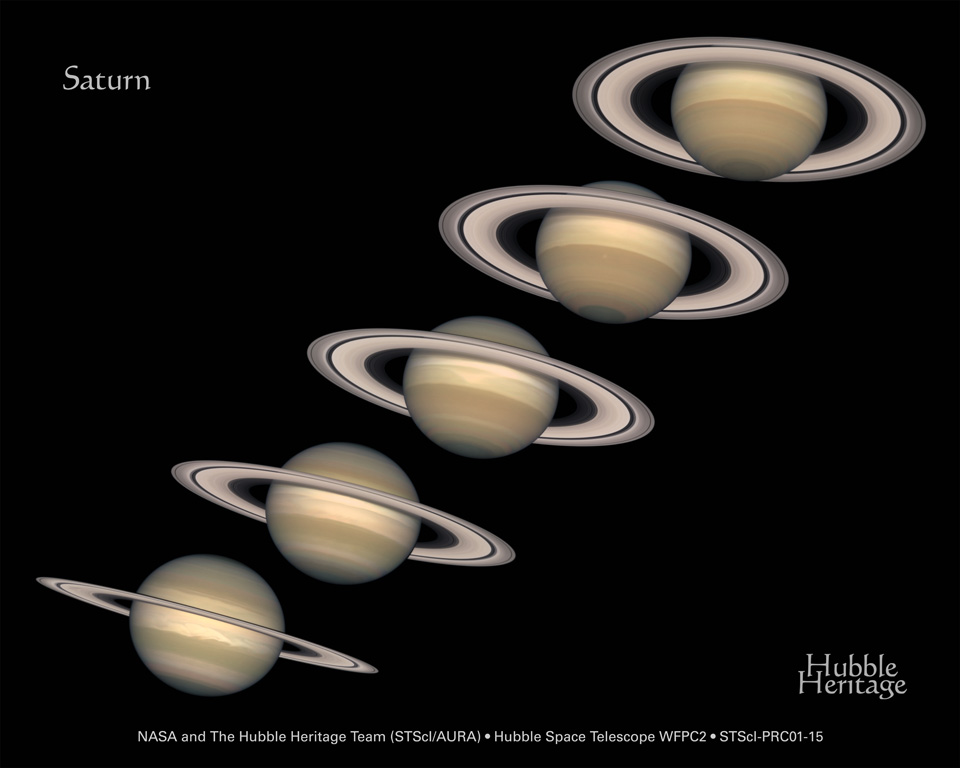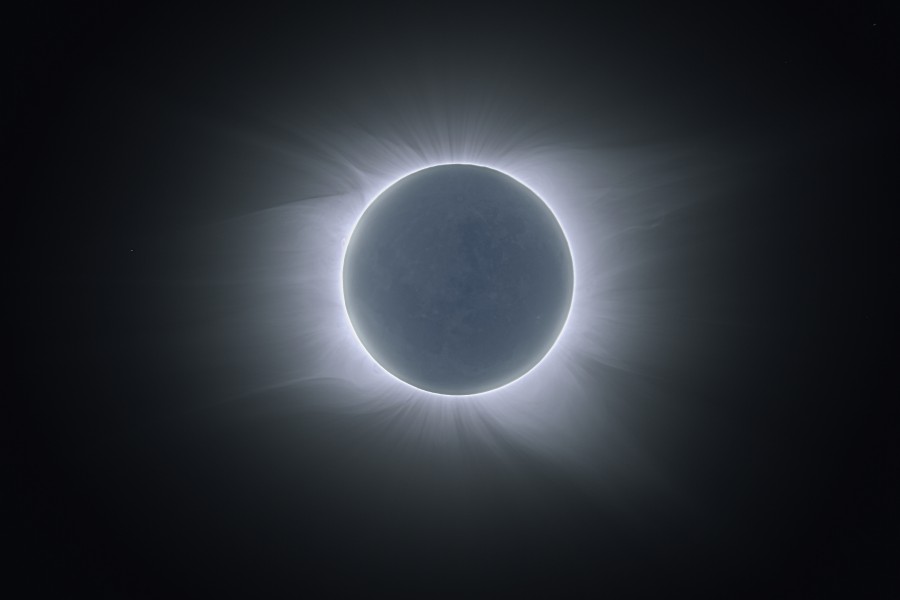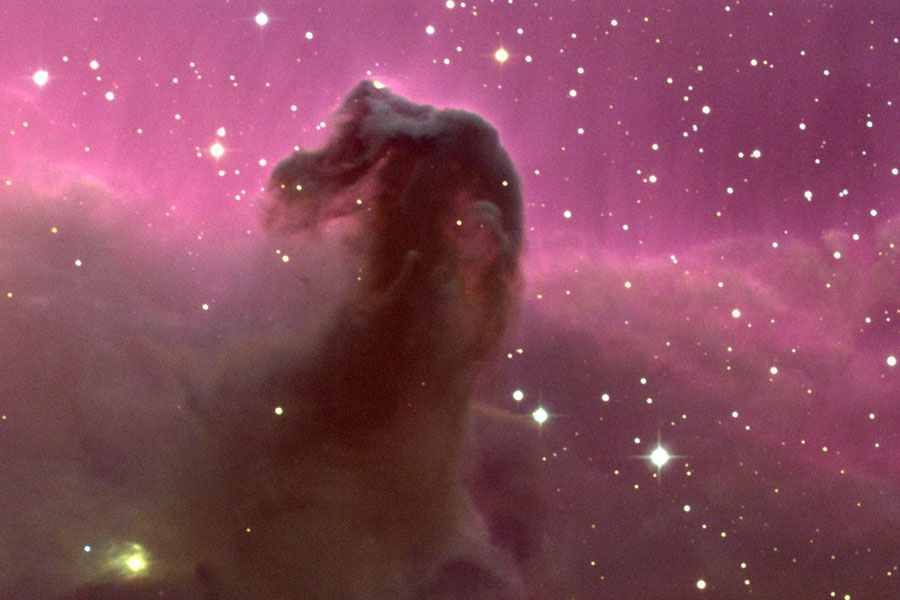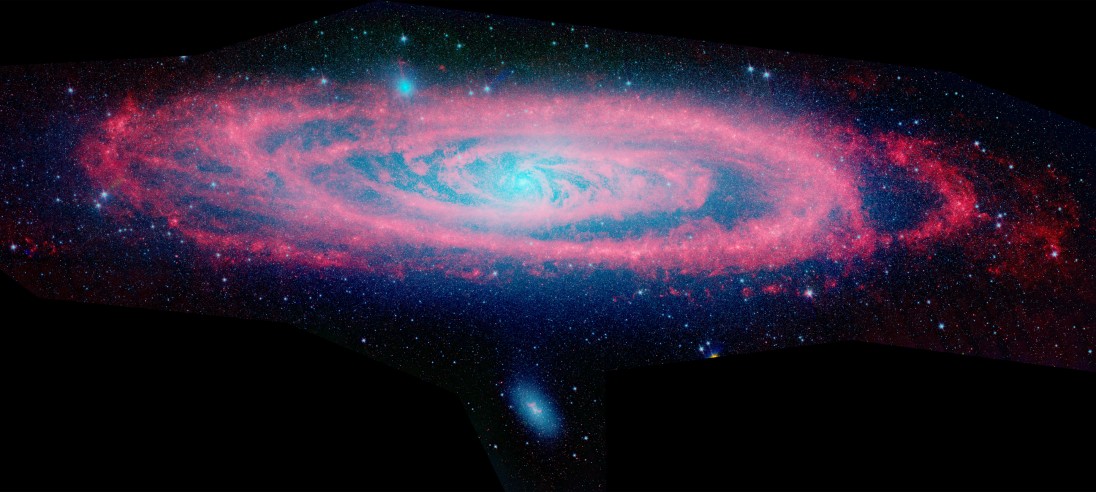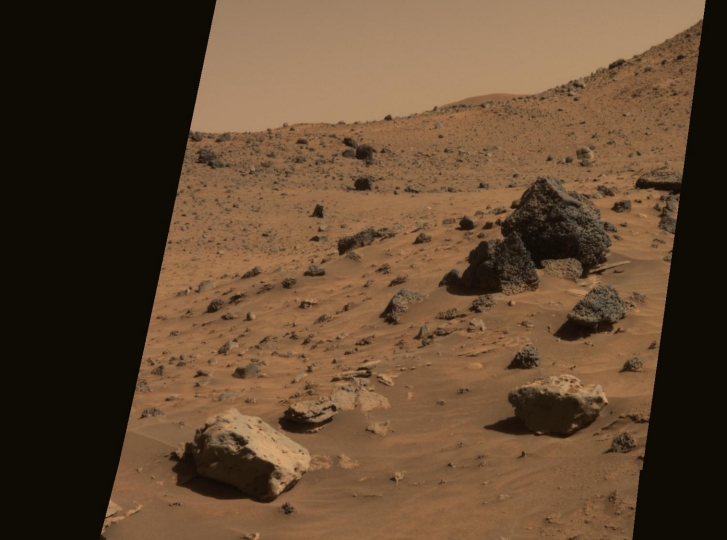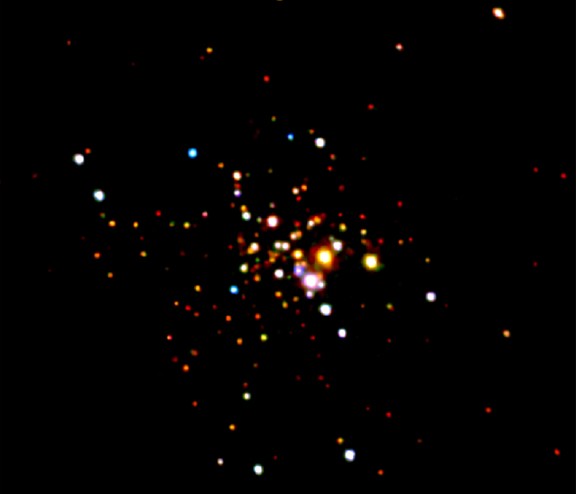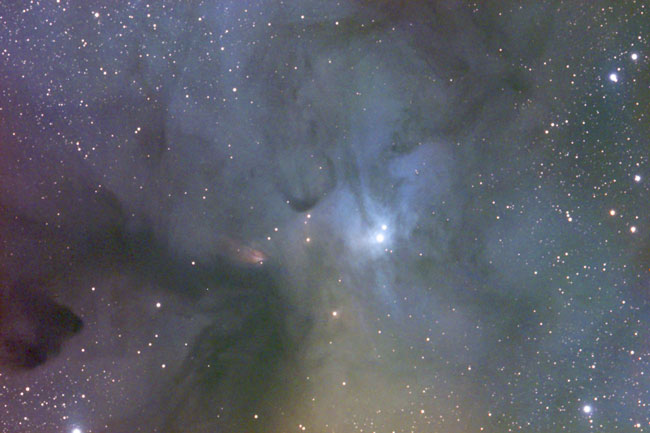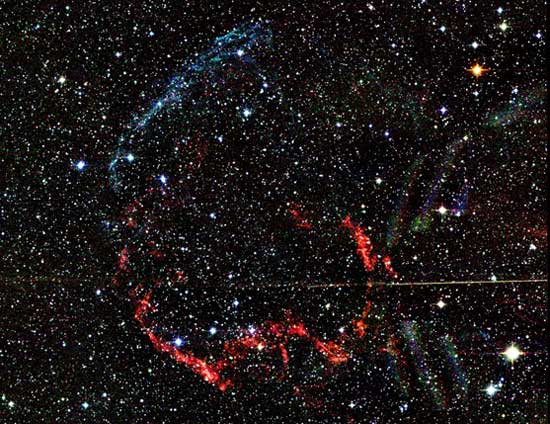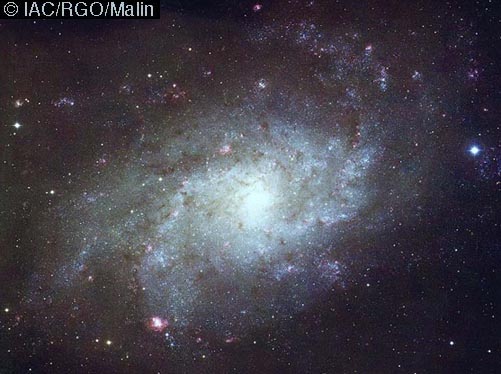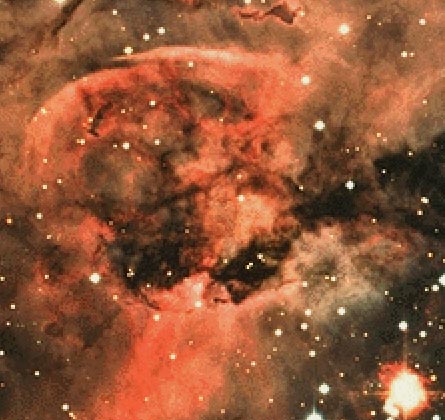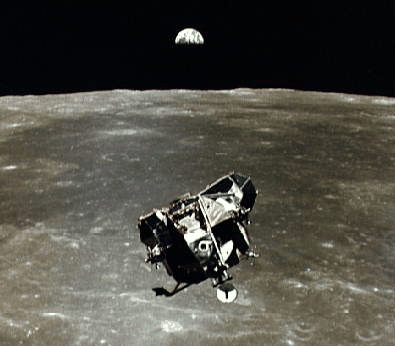| << Previous | Index | Next >> |
2015 After grazing the western horizon on northern summer evenings Comet PanSTARRS (also known as C/2014 Q1) climbed higher in southern winter skies. A visitor to the inner Solar System discovered in August 2014 by the prolific panSTARRS survey, the comet was captured here on July 17. Comet and colorful tails were imaged from Home Observatory in Mackay, Queensland, Australia. The field of view spans just over 1 degree. Sweeping quickly across a the sky this comet PanSTARRS was closest to planet Earth about 2 days later. Still, the faint stars of the constellation Cancer left short trails in the telescopic image aligned to track the comet's rapid motion. PanSTARRS' bluish ion tails stream away from the Sun, buffetted by the solar wind. Driven by the pressure of sunlight, its more diffuse yellowish dust tail is pushed outward and lags behind the comet's orbit. A good target for binoculars from southern latitudes, in the next few days the comet will sweep through skies near Venus, Jupiter, and bright star Regulus.
2014 Why does this comet's nucleus have two components? The surprising discovery that Comet 67P/Churyumov–Gerasimenko has a double nucleus came late last week as ESA's robotic interplanetary spacecraft Rosetta continued its approach toward the ancient comet's core. Speculative ideas on how the double core was created include, currently, that Comet Churyumov–Gerasimenko is actually the result of the merger of two comets, that the comet is a loose pile of rubble pulled apart by tidal forces, that ice evaporation on the comet has been asymmetric, or that the comet has undergone some sort of explosive event. Pictured above, the comet's unusual 5-km sized comet nucleus is seen rotating over the course of a few hours, with each frame taken 20-minutes apart. Better images -- and hopefully more refined theories -- are expected as Rosetta is on track to enter orbit around Comet Churyumov–Gerasimenko's nucleus early next month, and by the end of the year, if possible, land a probe on it.
2013
2012 Get out your red/blue glasses and check out this remarkable stereo view from lunar orbit. Created from two photographs (AS11-44-6633, AS11-44-6634) taken by astronaut Michael Collins during the 1969 Apollo 11 mission, the 3D anaglyph features the lunar module ascent stage, dubbed The Eagle, as it rises to meet the command module in lunar orbit on July 21. Aboard the ascent stage are Neil Armstrong and Buzz Aldrin, the first to walk on the Moon. The smooth, dark area on the lunar surface is Mare Smythii located just below the equator on the extreme eastern edge of the Moon's near side. Poised beyond the lunar horizon, is our fair planet Earth.
2011 The Parkes 64 meter radio telescope is known for its contribution to human spaceflight, famously supplying television images from the Moon to denizens of planet Earth during Apollo 11. The enormous, steerable, single dish looms in the foreground of this early evening skyscape. Above it, the starry skies of New South Wales, Australia include familiar southerly constellations Vela, Puppis, and Hydra along with a sight that will never be seen again. Still glinting in sunlight and streaking right to left just below the radio telescope's focus cabin, the space shuttle orbiter Atlantis has just undocked with the International Space Station for the final time. The space station itself follows arcing from the lower right corner of the frame, about two minutes behind Atlantis in low Earth orbit. Atlantis made its final landing early this morning (July 21, 5:57am EDT) at NASA's Kennedy Space Center.
2010 During a total solar eclipse, the Sun's extensive outer atmosphere, or corona, is an inspirational sight. Subtle shades and shimmering features that engage the eye span a brightness range of over 10,000 to 1, making them notoriously difficult to capture in a single photograph. But this composite of 7 consecutive digital images over a range of exposure times comes close to revealing the crown of the Sun in all its glory. The telescopic views were recorded from the Isla de Pascua (Easter Island) during July 11's total solar eclipse and also show solar prominences extending just beyond the edge of the eclipsed sun. Remarkably, features on the dim, near side of the New Moon can also be made out, illuminated by sunlight reflected from a Full Earth.
2009 One of the most identifiable nebulae in the sky, the Horsehead Nebula in Orion, is part of a large, dark, molecular cloud. Also known as Barnard 33, the unusual shape was first discovered on a photographic plate in the late 1800s. The red glow originates from hydrogen gas predominantly behind the nebula, ionized by the nearby bright star Sigma Orionis. The darkness of the Horsehead is caused mostly by thick dust, although the lower part of the Horsehead's neck casts a shadow to the left. Streams of gas leaving the nebula are funneled by a strong magnetic field. Bright spots in the Horsehead Nebula's base are young stars just in the process of forming. Light takes about 1,500 years to reach us from the Horsehead Nebula. The above image was taken with the 0.9-meter telescope at Kitt Peak National Observatory.
2008 What will become of these galaxies? Spiral galaxies NGC 5426 and NGC 5427 are passing dangerously close to each other, but each is likely to survive this collision. Most frequently when galaxies collide, a large galaxy eats a much smaller galaxy. In this case, however, the two galaxies are quite similar, each being a sprawling spiral with expansive arms and a compact core. As the galaxies advance over the next tens of millions of years, their component stars are unlikely to collide, although new stars will form in the bunching of gas caused by gravitational tides. Close inspection of the above image taken by the 8-meter Gemini-South Telescope in Chile shows a bridge of material momentarily connecting the two giants. Known collectively as Arp 271, the interacting pair spans about 130,000 light years and lies about 90 million light-years away toward the constellation of Virgo. Quite possibly, our Milky Way Galaxy will undergo a similar collision with the neighboring Andromeda Galaxy in about five billion years.
2007 This wide, detailed Spitzer Space Telescope view features infrared light from dust (red) and old stars (blue) in Andromeda, a massive spiral galaxy a mere 2.5 million light-years away. In fact, with over twice the diameter of our own Milky Way, Andromeda is the largest nearby galaxy. Andromeda's population of bright young stars define its sweeping spiral arms in visible light images, but here the infrared view clearly follows the lumpy dust lanes heated by the young stars as they wind even closer to the galaxy's core. Constructed to explore Andromeda's infrared brightness and stellar populations, the full mosaic image is composed of about 3,000 individual frames. Two smaller companion galaxies, NGC 205 (below) and M32 (above) are also included in the combined fields. The data confirm that Andromeda (aka M31) houses around 1 trillion stars, compared to 4 hundred billion for the Milky Way.
2006 This view from the winter station of Mars Exploration Rover Spirit, looks across the rock strewn landscape of Gusev Crater. The dark boulders and distant hills are characteristic of the region, but the two light colored rocks in the foreground of this cropped image are - like Spirit itself - most probably strangers to the Red Planet, believed to be iron meteorites. Informally named for sites in Antarctica they have been dubbed "Zhong Shan" and "Allan Hills." Zhong Shan is the Antarctic base of the People's Republic of China. Allan Hills is the icy location where many Martian meteorites have been found on planet Earth, including the controversial ALH84001, suggested to contain evidence for fossilized Martian microbial life.
2005 Visible light images show the central region of globular cluster 47 Tucanae is closely packed, with stars less than a tenth of a light-year apart. This Chandra false-color x-ray view of central 47 Tuc also shows the cluster is a popular neighborhood for x-ray stars, many of which are "normal" stars co-orbiting with extremely dense neutron stars -- stars with the mass of the Sun but the diameter of Manhattan Island. One of the most remarkable of these exotic binary systems is cataloged as 47 Tuc W, a bright source near the center of this image. The system consists of a low mass star and a a neutron star that spins once every 2.35 milliseconds. Such neutron stars are known to radio astronomers as millisecond pulsars, believed to be driven to such rapid rotation by material falling from the normal star onto its dense companion. In fact, x-ray observations of the 47 Tuc W system link this spin-up mechanism observed to operate in other x-ray binary stars with fast rotating millisecond pulsars.
2004 This picture of Saturn could not have been taken from Earth. No Earth based picture could possibly view the night side of Saturn and the corresponding shadow cast across Saturn's rings. Since Earth is much closer to the Sun than Saturn, only the day side of the planet is visible from the Earth. Rather, this picture was taken by the robot Cassini spacecraft that began orbiting Saturn earlier this month. The dark western limb of Saturn looms large on the image right, while complex concentrations of small ring particles reflect sunlight on the image left. Saturn's enigmatic F ring is visible around the outside, showing mysterious knots. The small moon Epimetheus, only about 100 kilometers across, can also been seen on the far left. Cassini is scheduled to drop a probe toward the largest moon Titan in December.
2003 Why does this starfield photograph resemble an impressionistic painting? The effect is created not by digital trickery but by large amounts of interstellar dust. Dust, minute globs rich in carbon and similar in size to cigarette smoke, frequently starts in the outer atmospheres of large, cool, young stars. The dust is dispersed as the star dies and grows as things stick to it in the interstellar medium. Dense dust clouds are opaque to visible light and can completely hide background stars. For less dense clouds, the capacity of dust to preferentially reflect blue starlight becomes important, effectively blooming the stars blue light out and marking the surrounding dust. Nebular gas emissions, typically brightest in red light, can combine to form areas seemingly created on an artist's canvas. Photographed above is roughly one square degree of the nebula IC 4603 near the bright star Antares toward the constellation of Ophiuchus.
2002 For such a close galaxy, NGC 4945 is easy to miss. NGC 4945 is a spiral galaxy in the Centaurus Group of galaxies, located only six times farther away than the prominent Andromeda Galaxy. The thin disk galaxy is oriented nearly edge-on, however, and shrouded in dark dust. Therefore galaxy-gazers searching the southern constellation of Centaurus need a telescope to see it. The above picture was taken with a large telescope testing a new wide-angle, high-resolution CCD camera. Most of the spots scattered about the frame are foreground stars in our own Galaxy, but some spots are globular clusters orbiting the distant galaxy. NGC 4945 is thought to be quite similar to our own Milky Way Galaxy. X-ray observations reveal, however, that NGC 4945 has an unusual, energetic, Seyfert 2 nucleus that might house a large black hole.
2001 On July 20, 1976, NASA's Viking 1 lander became the first U.S. spacecraft to land on Mars, followed weeks later by its twin robot explorer, the Viking 2 lander. Operating on the Martian surface into the early 1980s, the Vikings took thousands of pictures, conducted sophisticated chemical searches for life, and studied the martian weather and geology. In the dramatically detailed image above, a field of rocks and boulders is viewed from the Viking 1 landing site on Chryse Planitia (the Plain of Chryse). Viking 1's dusty foot pad is just visible at the lower right. The image was created by combining high resolution black and white images with lower resolution color images of the same area. NASA is continuing its well chronicled martian exploration program as the Mars Odyssey spacecraft is scheduled to arrive at the mysterious Red Planet on October 24th. What's Mars like today?
2000 From a delicate orbit around asteroid 433 Eros, the NEAR Shoemaker spacecraft's camera has now imaged the entire surface of the small oddly-shaped world at least once. Recorded on July 7th from a distance of 50 kilometers, this dramatic view is about 1.8 kilometers across. It shows the walls and rims of two large overlapping impact craters on the horizon. Massive boulders which may be debris from the impacts are perched along the crater edges. The prominent boulder on the horizon near picture center is about 40 meters long. In fact, the NEAR mission to Eros has shown that along with craters and boulders, grooves and ridges are also common on the asteroid's surface. While the craters are clearly of impact origin, puzzles about the other surface features still remain. On July 13, controllers fired the spacecraft thrusters and moved NEAR Shoemaker to an even closer 35 kilometer orbit to enable higher resolution surface studies.
1999 About 8000 years ago, a star in our Galaxy exploded. Ancient humans might have noticed the supernova as a temporary star, but modern humans can see the expanding shell of gas even today. In the above false-color infrared image of supernova remnant IC 443, blue denotes expanding gas where emission is dominated by excited iron atoms. Of particular interest, though, are the wisps of IC 443 colored red, as they are impacting an otherwise normal molecular cloud. Here emission from shock-excited molecular hydrogen is allowing astronomers to study how fast moving supernova gas affects star formation in the cloud. Additionally, astronomers theorize that the impact accelerates some particles to velocities near the speed of light. The horizontal line across the image is not part of the nebula.
1998 M33 is a prominent nearby spiral galaxy. Nicknamed the Triangulum, M33 is one of the larger members of the Local Group of Galaxies. Two massive spiral galaxies dominate the Local Group: M31 and our Milky Way Galaxy. M33 is the only other spiral galaxy known in the Local Group. At 3 million light-years, M33 is the second closest spiral galaxy. M33 is thought by some to be a satellite galaxy to massive M31. M33 is close enough to appear twice the angular size of the full moon, when viewed with binoculars. Globular clusters in M33's halo appear unusual and might be much younger than globular clusters in our Galaxy's halo.
1997 Stars, like people, do not always go gentle into that good night. The above Keyhole Nebula results from dying star Eta Carinae's violently casting off dust and gas during its final centuries. Eta Carinae is many times more massive than our own Sun, and should eventually undergo a tremendous supernova explosion. Eta Carinae emits much light in colors outside the human visible range. This past week, X-ray emission from Eta Carinae was verified by the orbiting Rossi X-Ray Timing Explorer to be periodic, peaking every 85.1 days. This, along with a previously hypothesized 5.52 year period, indicates that the dying star might be part of a multiple star system.
1996 On July 21, 1969 Apollo 11 astronauts Neil A. Armstrong and Edwin E. "Buzz" Aldrin Jr. lifted off the lunar surface in the ascent stage of their lunar module dubbed "The Eagle" -- after becoming the first to walk on the moon. Seen here the Eagle soars towards a rendezvous with the orbiting Command Module piloted by Michael Collins. The smooth, dark mare area on the surface below is Mare Smithii located just below the equator on the extreme eastern edge of the lunar nearside. The Earth is visible hanging above the moon's western horizon.
1995 Although images of Mars taken from space revealed the planet to have a barren and cratered surface, scientists did not give up the search for martian life. In 1976 NASA's Viking project succeeded in landing two robot probes on the surface of Mars. These landers were able to carry out sophisticated chemical experiments to look for signs of microscopic life in the martian soil. However, the experiments failed to produce any convincing evidence for life on Mars. Cameras onboard the Viking Landers also returned spectacular photos of the rocky martian landscape, like the one above, which showed no sign of martian animal or plant life.
| << Previous | Index | Next >> |

